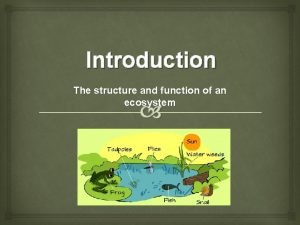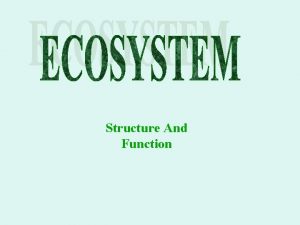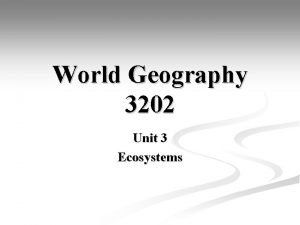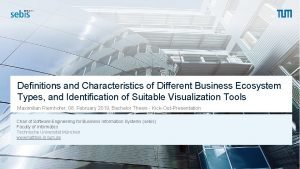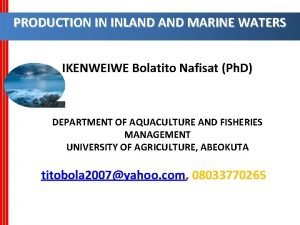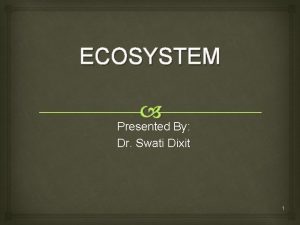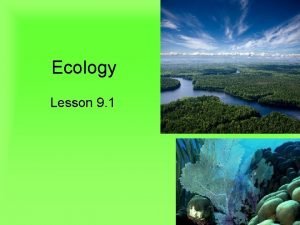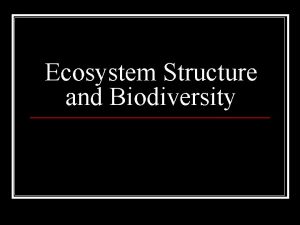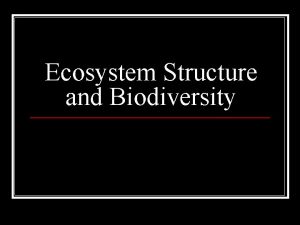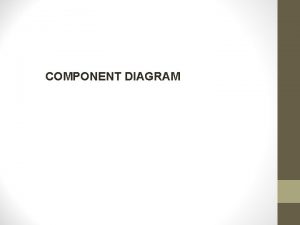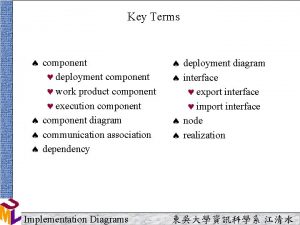Structure and component of an ECOSYSTEM Ecosystem characteristics














- Slides: 14

Structure and component of an ECOSYSTEM

Ecosystem characteristics • Ecosystem show large variations in their Ø Size Ø Structure Ø Composition etc. , All the ecosystem are characterized by certain basic structural and functional features which are common.

Structure of ecosystem • Composition and organization of biological communities and abiotic components constitute the structure of an ecosystem • Biotic structure abiotic structure Ø Producers Ø Consumers Ø Herbivores Ø Carnivores Ø Omnivores Ø Detritivores Ø Decomposers physical factors chemical factors

Biotic structure • The plants, animals and microorganisms present in an ecosystem form the biotic component. • These organism have different nutritional behavior and status in the ecosystems and are accordingly known as producers or consumers, based on how do they get their food.

producers Producer- all autotrophs (plants), they trap energy from the sun, co 2, Chlorophyll through photosynthesis. Chemo-autotrophs: microorganism which can produce organic matter through oxidation of certain chemicals in absence of sunlight. • Bottom of the food chain

Consumer all heterotrophs: they get their organic food by feeding on other organisms. • Herbivores • Carnivores • Omnivores • Detritivores

Herbivores Eat plants • Primary consumers • Prey animals • Eg: rabbit, insect, man JHANSIRANI. R AP/ECE

Consumer-Carnivores eat meat • Predators – Hunt prey animals for food. ØIf they feed on herbivores They are secondary consumers Eg: frog ØIf they feed on other carnivores they are tertiary consumers JHANSIRANI. R AP/ECE Eg: snake, big fish etc. ,

Consumer- Omnivores eat both plants and animals Eg: fox, many birds, humans. JHANSIRANI. R AP/ECE

Consumer- detritivores • Saprotrophs: they feed on parts of dead organisms, waste of living organism, and partially decomposed matter • Eg: beetles, termites, ants, earthworms etc. , JHANSIRANI. R AP/ECE

Decomposers • Breakdown the complex compounds of dead and decaying plants and animals into simpler molecules that can be absorbed • Eg: bacteria, fungi

Abiotic structure • Physical and chemical components of ecosystem constitute its abiotic structure. • It includes – Climatic factors – Edaphic factors – Geographical factors – Energy – Nutrients – Toxic substance.

Physical factors • • • The sunlight & shade Intensity of solar flux Duration of sun hours Average temperature Maximum & minimum temperature Annual rainfall Wind Latitude Altitude Soil type Water availability these features have strong influence on ecosystem.

Chemical factors • Availability of essential nutrients like Ø Carbon Ø Nitrogen Ø Phosphorus Ø Potassium Ø Hydrogen Ø Oxygen Ø Sulphur Ø Level of toxic substance Ø Salts causing salinity Ø Organic substance present in soil or water influences the functioning of ecosystem.
 Structure and function of an ecosystem
Structure and function of an ecosystem Deseart
Deseart World geography
World geography Business ecosystem map
Business ecosystem map Characteristics of marine ecosystem
Characteristics of marine ecosystem Detritus food chain
Detritus food chain Health and social care component 3
Health and social care component 3 Compare and contrast community and ecosystem
Compare and contrast community and ecosystem Compare and contrast biotic and abiotic factors
Compare and contrast biotic and abiotic factors Uml deployment and component diagram
Uml deployment and component diagram Components and composites ofsted
Components and composites ofsted Component and deployment diagram
Component and deployment diagram Health and social care component 1 coursework example
Health and social care component 1 coursework example Force diagram
Force diagram Health and social care component 2 learning aim b example
Health and social care component 2 learning aim b example
